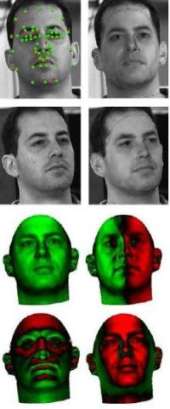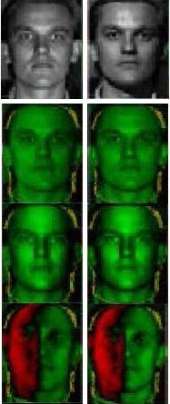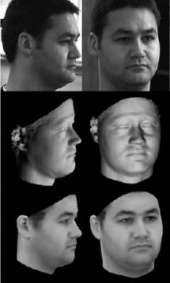
Face Analysis and Recognition under Variable Illumination
We are investigating face recognition methods from images taken under arbitrary illumination, where a low-dimensional spherical harmonics basis is computed for each image from a statistical representation of spherical harmonics images. Combined with a morphable shape model, this approach has given excellent results in re-synthesis of facial images under different pose, illumination and even expression.
- Selected publications:
 Face Relighting from a Single Image under Arbitrary Unknown Lighting Conditions, Wang, Y., Zhang, L., Liu, Z., Hua, G., Wen, Z., Zhang, Z., Samaras, D., In IEEE Transactions on Pattern Analysis and Machine Intelligence (PAMI) November 2009, vol. 31, no. 1, pp. 1968-1984
Face Relighting from a Single Image under Arbitrary Unknown Lighting Conditions, Wang, Y., Zhang, L., Liu, Z., Hua, G., Wen, Z., Zhang, Z., Samaras, D., In IEEE Transactions on Pattern Analysis and Machine Intelligence (PAMI) November 2009, vol. 31, no. 1, pp. 1968-1984
 Face Recognition from A Single Training Image under Arbitrary Unknown Lighting using Spherical Harmonics, Lei Zhang and Dimitris Samaras, In IEEE Trans on Pattern Analysis and Machine Intelligence, March 2006, Vol 28, No. 3, pp. 351-363
Face Recognition from A Single Training Image under Arbitrary Unknown Lighting using Spherical Harmonics, Lei Zhang and Dimitris Samaras, In IEEE Trans on Pattern Analysis and Machine Intelligence, March 2006, Vol 28, No. 3, pp. 351-363
- Former students:
- Lei Zhang
- Sen Wang
- Funding: Dept. of Justice (subcontract to Notre Dame), NSF-ITR (subcontract to Rutgers)
- Keywords: Face Recognition, Face Modeling, Illumination Representation
Face Relighting from a Single Image under Arbitrary Unknown Lighting Conditions
[publications]
In this paper, we present a new method to modify the appearance of a face image by manipulating the illumination condition, when the face geometry and albedo information is unknown. This problem is particularly difficult when there is only a single image of the subject available. Recent research demonstrates that the set of images of a convex Lambertian object obtained under a wide variety of lighting conditions can be approximated accurately by a low-dimensional linear subspace using a spherical harmonic representation. Moreover, morphable models are statistical ensembles of facial properties such as shape and texture. In this paper, we integrate spherical harmonics into the morphable model framework by proposing a 3D spherical harmonic basis morphable model (SHBMM). The proposed method can represent a face under arbitrary unknown lighting and pose simply by three low-dimensional vectors, i.e., shape parameters, spherical harmonic basis parameters, and illumination coefficients, which are called the SHBMM parameters. However, when the image was taken under an extreme lighting condition, the approximation error can be large, thus making it difficult to recover albedo information. In order to address this problem, we propose a subregion-based framework that uses a Markov random field to model the statistical distribution and spatial coherence of face texture, which makes our approach not only robust to extreme lighting conditions, but also insensitive to partial occlusions. The performance of our framework is demonstrated through various experimental results, including the improved rates for face recognition under extreme lighting conditions.
Publications
 Face Relighting from a Single Image under Arbitrary Unknown Lighting Conditions, Wang, Y., Zhang, L., Liu, Z., Hua, G., Wen, Z., Zhang, Z., Samaras, D., In IEEE Transactions on Pattern Analysis and Machine Intelligence (PAMI) November 2009, vol. 31, no. 1, pp. 1968-1984
Face Relighting from a Single Image under Arbitrary Unknown Lighting Conditions, Wang, Y., Zhang, L., Liu, Z., Hua, G., Wen, Z., Zhang, Z., Samaras, D., In IEEE Transactions on Pattern Analysis and Machine Intelligence (PAMI) November 2009, vol. 31, no. 1, pp. 1968-1984
[ BibTex ] Face Re-Lighting from a Single Image under Harsh Lighting Conditions, Yang Wang, Zicheng Liu, Gang Hua, Zhen Wen, Zhengyou Zhang, Dimitris Samaras, CVPR 2007
Face Re-Lighting from a Single Image under Harsh Lighting Conditions, Yang Wang, Zicheng Liu, Gang Hua, Zhen Wen, Zhengyou Zhang, Dimitris Samaras, CVPR 2007
[ BibTex ] Face Synthesis and Recognition under Arbitrary Unknown Lighting using a Spherical Harmonic Basis Morphable Model, Lei Zhang, Sen Wang, Dimitris Samaras, In IEEE Proc. of CVPR, pp. II: 209-216, 2005.
Face Synthesis and Recognition under Arbitrary Unknown Lighting using a Spherical Harmonic Basis Morphable Model, Lei Zhang, Sen Wang, Dimitris Samaras, In IEEE Proc. of CVPR, pp. II: 209-216, 2005.
[ BibTex ] Pose Invariant Face Recognition Under Arbitrary Unknown Lighting Using Spherical Harmonics, Lei Zhang and Dimitris Samaras, In Proc. Biometric Authentication Workshop 2004 (in conjunction with ECCV2004), pp. 10-23.
Pose Invariant Face Recognition Under Arbitrary Unknown Lighting Using Spherical Harmonics, Lei Zhang and Dimitris Samaras, In Proc. Biometric Authentication Workshop 2004 (in conjunction with ECCV2004), pp. 10-23.
[ BibTex ]
Face Recognition from a Single Training Image under Arbitrary Unknown Lighting Using Spherical Harmonics
[publications]
In this paper, we propose two novel methods for face recognition under arbitrary unknown lighting by using spherical harmonics illumination representation, which require only one training image per subject and no 3D shape information. Our methods are based on the recent result which demonstrated that the set of images of a convex Lambertian object obtained under a wide variety of lighting conditions can be approximated accurately by a low-dimensional linear subspace. We provide two methods to estimate the spherical harmonic basis images spanning this space from just one image. Our first method builds the statistical model based on a collection of 2D basis images. We demonstrate that, by using the learned statistics, we can estimate the spherical harmonic basis images from just one image taken under arbitrary illumination conditions if there is no pose variation. Compared to the first method, the second method builds the statistical models directly in 3D spaces by combining the spherical harmonic illumination representation and a 3D morphable model of human faces to recover basis images from images across both poses and illuminations. After estimating the basis images, we use the same recognition scheme for both methods: we recognize the face for which there exists a weighted combination of basis images that is the closest to the test face image. We provide a series of experiments that achieve high recognition rates, under a wide range of illumination conditions, including multiple sources of illumination. Our methods achieve comparable levels of accuracy with methods that have much more onerous training data requirements. Comparison of the two methods is also provided.
Publications
 Face Recognition from A Single Training Image under Arbitrary Unknown Lighting using Spherical Harmonics, Lei Zhang and Dimitris Samaras, In IEEE Trans on Pattern Analysis and Machine Intelligence, March 2006, Vol 28, No. 3, pp. 351-363
Face Recognition from A Single Training Image under Arbitrary Unknown Lighting using Spherical Harmonics, Lei Zhang and Dimitris Samaras, In IEEE Trans on Pattern Analysis and Machine Intelligence, March 2006, Vol 28, No. 3, pp. 351-363 Face Recognition Under Variable Lighting Using Harmonic Image Exemplars, Lei Zhang and Dimitris Samaras, In Proc. CVPR 2003, pp. I: 19-25.
Face Recognition Under Variable Lighting Using Harmonic Image Exemplars, Lei Zhang and Dimitris Samaras, In Proc. CVPR 2003, pp. I: 19-25.
[ BibTex ]
Face Reconstruction Across Different Poses and Arbitrary Illumination Conditions
[publications]
In this paper, we present a novel method for face reconstruction from multi-posed face images taken under arbitrary unknown illumination conditions. Previous work shows that any face image can be represented by a set of low dimensional parameters: shape parameters, spherical harmonic basis (SHB) parameters, pose parameters and illumination coefficients. Thus, face reconstruction can be performed by recovering the set of parameters from the input images. In this paper, we demonstrate that the shape and SHB parameters can be estimated by minimizing the silhouettes errors and image intensity errors in a fast and robust manner. We propose a new algorithm to detect the corresponding points between the 3D face model and the input images by using silhouettes. We also apply a model-based bundle adjustment technique to perform this minimization. We provide a series of experiments on both synthetic and real data and experimental results show that our method can have an accurate face shape and texture reconstruction.
Publications
 Face Reconstruction across Different Poses and Arbitrary Illumination Conditions, Sen Wang, Lei Zhang, Dimitris Samaras, In Audio- and Video-based Biometric Person Authentication, pp. 91-101, 2005.
Face Reconstruction across Different Poses and Arbitrary Illumination Conditions, Sen Wang, Lei Zhang, Dimitris Samaras, In Audio- and Video-based Biometric Person Authentication, pp. 91-101, 2005.
[ BibTex ]
